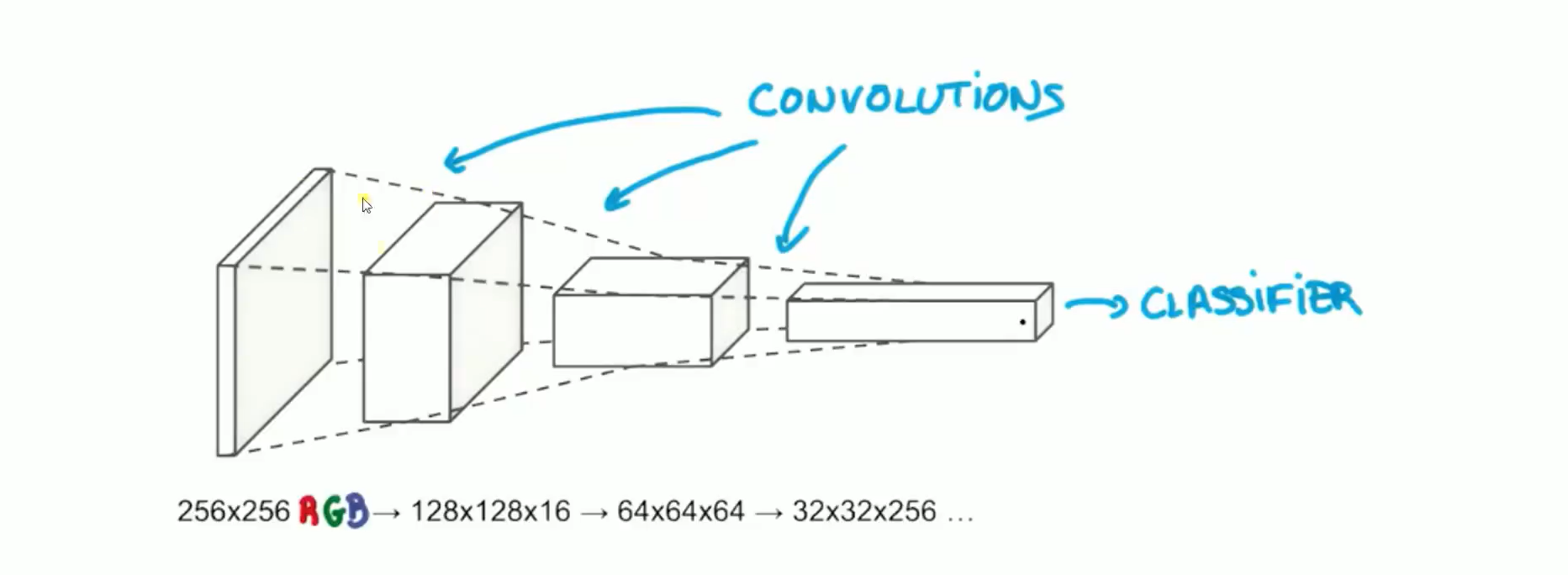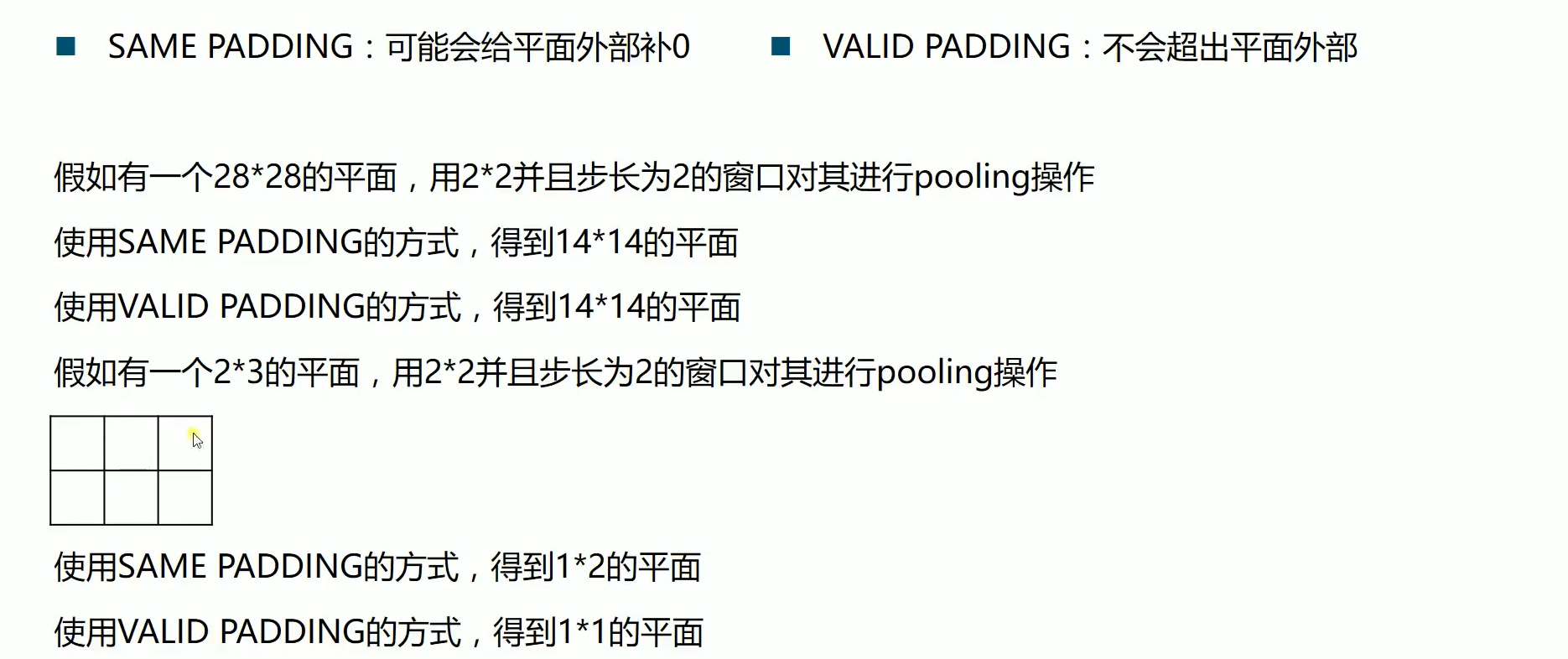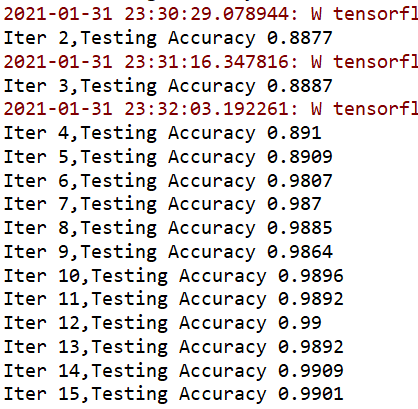卷积神经网络CNN
结构

池化操作

手写数字-卷积神经网络实现
import tensorflow as tf from tensorflow.examples.tutorials.mnist import input_data tf.compat.v1.disable_eager_execution() import numpy as np #载入数据集 mnist=input_data.read_data_sets("MNIST_data",one_hot=True) #每个批次大小 batch_size=100 #计算一共有多少个批次 n_bath=mnist.train.num_examples // batch_size #初始化权值 def weight_variable(shape): initial=tf.compat.v1.truncated_normal(shape,stddev=0.1)#生成一个截断的正态分布 return tf.Variable(initial) #初始化偏置值 def bias_variable(shape): initial=tf.compat.v1.constant(0.1,shape=shape)#生成一个截断的正态分布 return tf.Variable(initial) #卷积层 def conv2d(x,W): #strides[0]=strides[3]=1,strides[1]代表x方向的步长,strides[2]代表y方向的步长 return tf.nn.conv2d(x,W,strides=[1,1,1,1],padding='SAME') #池化层 def max_pool_2x2(x): #ksize[1,x,y,1] return tf.nn.max_pool(x,ksize=[1,2,2,1],strides=[1,2,2,1],padding='SAME') #定义两个placeholder x=tf.compat.v1.placeholder(tf.float32,[None,784])#28*28 y=tf.compat.v1.placeholder(tf.float32,[None,10]) #改变x的格式转为4D的向量【batch,in_height,in_width,in_channels】 x_image=tf.compat.v1.reshape(x,[-1,28,28,1]) #初始化第一个卷积层的权值和偏置 W_conv1=weight_variable([5,5,1,32])#5*5的采样窗口,32个卷积核从1个平面抽取特征 b_conv1=bias_variable([32])#每一个卷积核一个偏置值 #把x_image和权值向量进行卷积,再加上偏置值,然后应用于relu激活函数 h_conv1=tf.nn.relu(conv2d(x_image,W_conv1)+b_conv1) h_pool1=max_pool_2x2(h_conv1)#进行max-pooling #初始化第二个卷积层的权值和偏置 W_conv2=weight_variable([5,5,32,64])#5*5的采样窗口,64个卷积核从32个平面抽取特征 b_conv2=bias_variable([64])#每一个卷积核一个偏置值 #把x_image和权值向量进行卷积,再加上偏置值,然后应用于relu激活函数 h_conv2=tf.nn.relu(conv2d(h_pool1,W_conv2)+b_conv2) h_pool2=max_pool_2x2(h_conv2)#进行max-pooling #28*28的图片第一次卷积后还是28*28(步长为1),第一次池化变为14*14(因为步长2) #第二次卷积后为14*14,第二次池化为7*7 #经过以上步骤后得到64张7*7平面 #初始化第一个全连接层的权值 W_fc1=weight_variable([7*7*64,1024])#上一层有7*7*64个神经元,全连接层有1024个神经元 b_fc1=bias_variable([1024])#1024个节点 #把池化层的第二层输出扁平化为1维 h_pool2_flat=tf.compat.v1.reshape(h_pool2,[-1,7*7*64]) #求第一个全连接层的输出 h_fc1=tf.nn.relu(tf.matmul(h_pool2_flat,W_fc1)+b_fc1) #用keep_prob来表示神经元的输出概率 # keep_prob=tf.compat.v1.placeholder(tf.float32) # h_fc1_drop=tf.nn.dropout(h_fc1,keep_prob) #初始化第二个全连接层的权值 W_fc2=weight_variable([1024,10])#上一层有7*7*64个神经元,全连接层有1024个神经元 b_fc2=bias_variable([10])#1024个节点 #计算输出 prediction=tf.nn.softmax(tf.matmul(h_fc1,W_fc2)+b_fc2) #交叉熵函数 loss=tf.reduce_mean(tf.nn.softmax_cross_entropy_with_logits(labels=y,logits=prediction)) #梯度下降 train_step=tf.compat.v1.train.AdamOptimizer(1e-4).minimize(loss) #初始化变量 init=tf.compat.v1.global_variables_initializer() #结果存放在一个布尔型列表中 #返回的是一系列的True或False argmax返回一维张量中最大的值所在的位置,对比两个最大位置是否一致 correct_prediction=tf.equal(tf.argmax(y,1),tf.argmax(prediction,1)) #求准确率 #cast:将布尔类型转换为float,将True为1.0,False为0,然后求平均值 accuracy=tf.reduce_mean(tf.cast(correct_prediction,tf.float32)) with tf.compat.v1.Session() as sess: sess.run(init) for epoch in range(51): for batch in range(n_bath): #获得一批次的数据,batch_xs为图片,batch_ys为图片标签 batch_xs,batch_ys=mnist.train.next_batch(batch_size) #进行训练 sess.run(train_step,feed_dict={x:batch_xs,y:batch_ys}) test_acc=sess.run(accuracy,feed_dict={x:mnist.test.images,y:mnist.test.labels}) print("Iter "+str(epoch)+",Testing Accuracy "+str(test_acc))
输出结果:
跑的时间有点长。。。。。
